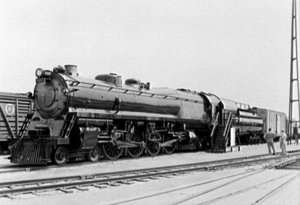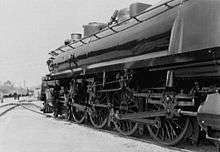4-4-4-4


A 4-4-4-4 steam locomotive, in the Whyte notation for describing locomotive wheel arrangements, has a four-wheel leading truck, two sets of four driving wheels, and a four-wheel trailing truck.
Other equivalent classifications are:
UIC classification: 2BB2 (also known as German classification and Italian classification)
French classification: 2222
Turkish classification: 2424
Swiss classification: 2/4+2/4 up to the early 1920s, later 4/8
While it would be possible to make an articulated locomotive of this arrangement, the only 4-4-4-4s ever built were duplex locomotives—with two sets of cylinders driving two sets of driven wheels in one rigid frame.
The first locomotive built with this arrangement was the Baltimore and Ohio Railroad's sole class N-1 #5600 George H. Emerson. To reduce the fixed wheelbase, this locomotive had the two sets of cylinders at opposite ends, so that the rear pair were beside the firebox. This proved to be a poor design, as it restricted the firebox size and exposed the cylinders to dust and dirt, causing premature wear. The locomotive was not considered successful enough to duplicate.
Next were the Pennsylvania Railroad's 52 class T1 locomotives. These had the cylinders in front of the wheels they drove, so that the rear pair were between the two sets of drivers. These locomotives were impressive performers but suffered from wheelslip and severe reliability problems, and did not last long in service.
Several bush tramway engine types were built with this wheel arrangement. These were known as "16-Wheelers". Two notable builders were J. Johnson and Sons Ltd, Invercargill, and A & G Price, Thames, New Zealand.